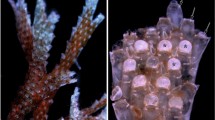Abstract
Schizoporella unicornis floridana Osburn from Maryland and New Jersey, USA, produces two types of autozoids: (1) “primogenial” zoids, arranged in the brick-like “quincunx” pattern usual among cheilostomes; (2) “adventitious”, or frontally-budded zoids. Adventitious zoids are produced by expansion of the epitheca of primogenial or other adventitious zoids. The old aperture is sealed over and the hypostega becomes the body cavity of a new zoid. Vertical walls of adventitious zoids all contain an intercalary cuticle; basal walls are the frontal walls of zoids beneath. This sometimes results in trepostome-like zoid columns arising from the substrate; zoid columns may bifurcate in a way similar to zoid row-bifurcation in primogenial zoids. Adventitious zoids communicate with zoids at the same depth in the colony through annular septulae; they communicate with younger and older zoids through areolae. Adventitious zoids may sometimes give rise to primogenial subcolonies, which overgrow the colony surface. Frontal budding allows the development of massive nodules, which are of geological importance. These findings indicate that the hypostegal coelom is at least potentially a bud, and that genetic “information” necessary for producing an autozoid may be transferred from one building site to another. This idea has important implications in studying evolution of positions of zoids in a colony.
Similar content being viewed by others
Literature cited
Banta, W. C.: The body wall of the encrusting cheilostome, Watersipora nigra (Canu and Bassler). Atti Social. Sci. nat. 108, 93–96 (1968a).
— The body wall of cheilostome Bryozoa. I. The ectocyst of Watersipora nigra (Canu and Bassler). J. Morph. 125 (4), 497–506 (1968b)
— The body wall of cheilostome Bryozoa, II. Interzoidal communication organs. J. Morph. 129, (2), 149–169 (1969).
— The body wall of cheilostome Bryozoa, IV. The frontal wall of Schizoporella unicornis (Johnston). J. Morph. 135 (2), 65–84 (1971).
Canu, F. and R. S. Bassler: North American early Tertiary Bryozoa. Bull. U.S. natn. Mus. 106, 1–879 (1920).
— North American later Tertiary and Quaternary Bryozoa. Bull. U.S. natn. Mus. 125, 1–47 (1923).
Cheetham, A. H., J. B. Rucker and R. E. Carver: Wall structure and minerology of the cheilostome bryozoan, Metrarabdotos. J. Paleont. 43 (1), 129–135 (1969).
Davenport, C. B.: Observations on budding in Paludicella and some other Bryozoa. Bull. Mus. comp. Zool. Harv. 22, 1–114 (1891).
Hoffmeister, J. E., K. W. Stockman and H. G. Multer: Miami limestone of Florida and its Recent Bahamian counterpart. Bull. geol. Soc. Am. 78, 175–190 (1967).
Hyman, L. H.: The invertebrates: smaller coelomate groups, 783 pp. New York: McGraw Hill Co. 1959.
Johnston, G.: A history of the British zoophytes, Second ed. 488 pp. London: John van Voorst 1847.
Kier, P. M., R. E. Grant and E. L. Yochelson: Whitening fossils. In: Handbook of paleontological techniques, pp. 453–456. Ed. by B. Krummel and D. Raup. New York: W. H. Freeman 1965.
Larwood, G. P., A. W. Medd, D. E. Owen and R. Tavener-Smith: Bryozoa. In: The fossil record, Chapter 11. pp. 379–395. London: Geological Society 1967.
Lutaud, G.: Contribution à l'étude du bourgeonnement et de la croissance des colonies chez Membranipora membranacea (Linné) bryozoaire chilostome. Annls Soc. zool. Belg. 91 (2), 157–300 (1961).
Nitsche, H.: Beiträge zur Kenntnis der Bryozoen, III. Über die Anatomie und Entwicklungsgeschichte von Flustra membranacea. Z. wiss. Zool. 21, 416–470 (1871).
Nye, O. B., D. A. Dean and R. W. Hinds: Improved thinsection techniques for fassil and Recent organisms. J. Paleont. (In press).
Oliver, W. A.: Some aspects of colony development in corals. J. Paleont. 42 (5), (Suppl. II), 16–34 (1968).
Osburn, R. C.: The Bryozoa of the Woods Hole region. Bull. Bur. Fish., Wash. 30, (760), 203–266 (1912).
Silén, L.: On the formation of the interzoidal communications of the Bryozoa. Zool. Bidr. Upps. 22, 433–488 (1944).
Smitt, F. A.: Om Hafs-Bryozoernas utveckling och fettkroppar. Öfvers. K. VetenskAkad. Förh. 22 (1), 5–50 (1865).
— Floridian Bryozoa, collected by Count L. F. de Pourtales. Part II. K. svenska VetenskAkad. Handl. 11 (4), 1–84 (1873).
Soule, D. F. and J. D. Soule: The Ectoprocta (Bryozoa) of Scammon's Lagoon, Baja California, Mexico. Am. Mus. Novit. 2199, 1–56 (1967).
Taverner-Smith, R. and A. Williams: Structure of the compensation sac in two ascophoran bryozoans. Proc. R. Soc. (Ser. B) 175, 235–254 (1970).
Author information
Authors and Affiliations
Additional information
Communicated by J. Bunt, Miami
This research, conducted in the Department of Invertebrate Paleontology at the National Museum of Natural History and at The American University, was supported in part by a Smithsonian Institution Visiting Postdoctoral Research Fellowship and by an American University Summer Research Grant, funded by a National Science Foundation Institutional Grant.
Rights and permissions
About this article
Cite this article
Banta, W.C. The body wall of cheilostome Bryozoa, V. Frontal budding in Schizoporella unicornis floridana . Mar. Biol. 14, 63–71 (1972). https://doi.org/10.1007/BF00365783
Accepted:
Issue Date:
DOI: https://doi.org/10.1007/BF00365783




